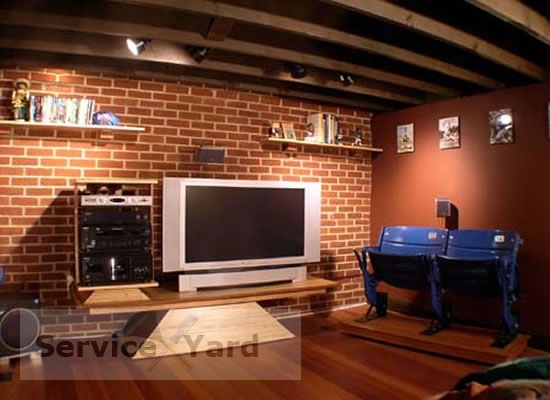How to remove old paint

During the repair, you encounter old paint under the wallpaper, layers of oil paint on the walls in the bathroom, especially in shock the appearance of “tightly” painted concrete introduces. The problem of how to remove the old paint seems, at first glance, insoluble, but do not rush to give up - there are no unsolvable problems. In this article, we will give some effective ways to remove old paint from all kinds of surfaces.
to contents ↑Where to begin?
 If you plan not to waste time on the laborious process of removing paint - sheathe the walls with plasterboard or decorate with plastic panels. But in order to make a good and high-quality repair and to clean the walls well of old paint, which has been stratified over the years of dirt, we recommend that you work hard.
If you plan not to waste time on the laborious process of removing paint - sheathe the walls with plasterboard or decorate with plastic panels. But in order to make a good and high-quality repair and to clean the walls well of old paint, which has been stratified over the years of dirt, we recommend that you work hard.
Before you remove the old paint from the walls, set the course of your actions:
- Stock up on personal protective equipment: gloves, glasses, respirator.
- Cover the floor with plastic wrap or old newspapers to prevent dirt from spreading around the room.
- Determine the type of surface with which you will remove the coating.
- Find out what type of paint was used, the approximate thickness of the layer and the degree of its strength.
- Choose convenient tools and tools for you.
- Start with the simplest methods, move on to more complex ones, and combine them if necessary.
- In the process, sharpen tools to quickly get the desired result of clean walls.
What is the paint on the walls?
Most often there are three types of solutions:
- oil;
- water emulsion;
- acrylic.
to contents ↑Important! The most difficult to remove is oily. In Soviet times, almost all surfaces were painted with oil paint - cheaply and “angrily”, it holds especially firmly on uncoated concrete.
How to remove old paint?
There are several effective ways to remove old paint. In general, there are three main ones:
- Chemical;
- Thermal;
- Mechanical.
Consider each method individually, its disadvantages and advantages.
to contents ↑Chemical solvent paint removal
The use of special solvents greatly simplifies the task of removing unnecessary coatings. But at the same time, one should not forget about the disadvantages of such a solution - this:
- high toxicity;
- burn hazard;
- chemicals emit a persistent specific smell;
- requires special disposal of funds;
- considerable expenditure of cash.
How to wash off the paint?
Means for removing paint from the walls in this case are suitable such:
- chemicals - special solvents;
- potassium carbonate (soda ash);
- lime;
- a piece of chalk;
- liquid glass;
- spatula of different widths;
- paint brush, roller;
- sandpaper.
How to remove old paint?
We offer an effective way to remove old oil paint from walls using a special solvent. This option is suitable for other types of paints. Proceed as follows:
- Prepare the chemical solution according to the instructions.
- Apply the product on the surface to be cleaned with a paint brush or roller, moving in one direction starting from the top of the wall.
- To more effectively remove paint from concrete, apply the solvent mixture in several approaches.
- Set the exposure time depending on the thickness of the paint layer.
- Use soft spatula to remove softened paint using a spatula from below the wall.
- Remove any residue with a stiff brush or sandpaper.
- Wash the surface of the chemical several times with a solution of soda ash or detergent, rinse with water.
Important! If the decorative coating is applied in several layers, repeat the process until the dye is completely removed.
 Several ways to remove paint from wooden surfaces:
Several ways to remove paint from wooden surfaces:
- Method 1:
- Wet the board with water.
- Sprinkle a thick layer of soda ash.
- Cover with wet burlap.
- Leave for a day, periodically wetting the tissue.
- Remove paint with a spatula.
- Wash away the remains with a special paint remover.
- Method 2:
- Make a mixture: 400 g of potassium carbonate, 200 g of crushed chalk with 1 kg of quicklime, dissolve in water until liquid sour cream is formed.
- Brush the surface.
- Soak 12 hours.
- Remove the dissolved mass in the manner described above.
Important! This method will be effective in case of not very old paint.
- Method 3:
- Liquid glass will help you remove the paint.
- Lubricate the surface with a substance.
- Wait until it is completely dry.
- Remove loose silicate film with a spatula.
- Repeat the procedure depending on the effect of exposure.
Safety regulations
Please note the following caveats:
- Observe safety rules for the use of chemicals.
- Work only in a well-ventilated area.
- Protect all parts of the body from acid and solvents with personal protective equipment.
- Drink plenty of fluids during operation.
Heat Removal
Softening such a decorative solution by heating also significantly speeds up the process. In this case, immediately prepare the following tools:
- building hair dryer;
- iron;
- foil.
Important! Pros:
- removes even the most old layers;
- it can be used in places where shock and vibration (window frames, glazed doors) are unacceptable.
Minuses:
- when exposed to high temperatures, a pungent odor and toxic substances are released on the paint;
- can not be used on decorative, plastic surfaces;
- heating of the surface in places where electrical wiring is not allowed.
How to remove paint by heating?
Method 1 - the use of iron and foil. Please note that the size of the foil sheet must be larger than the area of the bottom of the iron. Proceed as follows:
- Visually distribute the area to be cleaned.
- Apply a piece of foil to the painted surface.
- Heat the iron.
- Attach.
- Clean the molten material with a spatula.
- Clean up the remains with sandpaper.
Method 2 - use a building hair dryer. Make sure that the work does not take much time:
- Direct a stream of hot air to the problem area.
- Clean as it melts.
to contents ↑Important! Carefully use a hair dryer on glazed surfaces.
Removing old paint mechanically
For this purpose, the following tools are suitable for you:
- ax;
- hammer;
- chisel.
Important! Pros:
- least harmful method;
- lack of chemical effects on the body and the environment;
- no processing after chemicals;
- conveniently in poorly ventilated rooms;
- does not require large cash costs;
- Suitable for processing small areas.
Minuses:
- slow;
- laborious;
- traumatic.
How to remove paint?
 1st option. This method is used for the problem of how to remove paint from the walls in the bathroom for further facing the walls with ceramic tiles. Do this:
1st option. This method is used for the problem of how to remove paint from the walls in the bathroom for further facing the walls with ceramic tiles. Do this:
-
- Take a small ax and make notches.
- Tap on the surface, making small gaps between strokes.
- In corners and inaccessible places, remove the coating with a wide chisel, hitting it with the back of an ax or hammer.
Important! If the paint is completely removed, sand the surface with sandpaper, wipe with a damp cloth.
2nd option. To remove old paint such as a water-based emulsion or acrylic, warm water is additionally required. The scheme of work will be as follows:
-
- Make an incision with an ax.
- Apply water to the surface in a way that is convenient for you: spray, rag, roller.
- Leave to soak.
- Use a sharp ax to brush paint off the walls at a slight angle.
- Remove the remains with a spatula.
Important! Remove paint in one direction by moving clockwise.
3rd option. To remove acrylic paint, use a metal brush or coarse-grained skin - carefully process the entire surface in a circular motion. If the paint is of high quality, it will be difficult to remove. If you plan to cover the same surface again with acrylic paint, you can not remove the old layer.
to contents ↑How to remove old paint from the walls electromechanically?
The use of power tools significantly accelerates the mechanical removal of old decorative coatings. If you have the right tools, feel free to use them - this:
- a grinder with a wide range;
- chain nozzle drill;
- puncher with a wide chisel or nozzle - a crown on a brick.
Important! Pros - efficiently and quickly removes all types of paints from all kinds of surfaces.
Minuses:
- a large amount of dust is generated;
- pieces of plaster and concrete may crack off with paint;
- the instrument produces a loud sound and consumes a lot of electricity;
- high wear of nozzles;
- the tool is not always available;
- way notSuitable for walls made of thin and crumbling materials.
What you need to know about this method?
Before removing old paint, follow the procedure:
- If there are furniture in the room, cover them.
- Work with a respirator and goggles.
- Open the windows to the room so that the air will blow dust away.
- Use a vacuum cleaner during operation.
- Humidify the room periodically with a spray gun so that the dust from the paint settles along with moisture.
Important! A grinder with a wide range will help you speed up the work of cleaning old paint, but be prepared that there will be a lot of dust in this process.
How to remove old paint from concrete?
to contents ↑Stock footage
A drill with a chain nozzle is perfect - a chain of several links acts like a mini puncher - the paint is beaten off in pieces. Proceed in the following order:
- Put the chain on the drill, tighten the nut.
- Turn the drill to the left.
- Continue through the entire coverage, knocking it down.
- If the end link becomes unusable, remove from the opposite side for balance.
Important! When working with a drill, you must be protected.
Now you will no longer have questions about how to remove old paint from the walls in the bathroom, in the kitchen or any other room. Follow our tips, and the work will not last long!
- How to choose a vacuum cleaner taking into account the characteristics of the house and coatings?
- What to look for when choosing a water delivery
- How to quickly create comfort at home - tips for housewives
- How to choose the perfect TV - useful tips
- What to look for when choosing blinds
- What should be running shoes?
- What useful things can you buy in a hardware store
- Iphone 11 pro max review
- Than iPhone is better than Android smartphones



